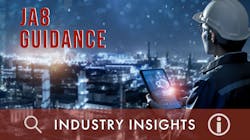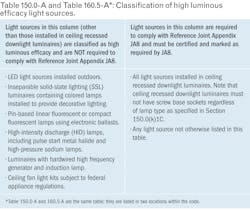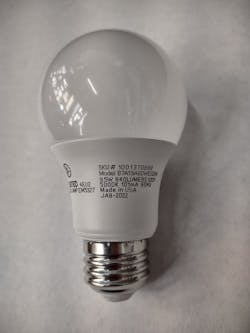INDUSTRY INSIGHTS | Demystifying Title 24, Part 6 Joint Reference Appendix 8
In this article, educators from Energy Code Ace dive into lighting performance requirements as outlined in California’s Building Energy Efficiency Standards (Title 24, Part 6 or the Energy Code), explaining the Energy Code’s Joint Reference Appendix JA8, its importance to lighting designers, contractors, and builders, how to find compliant products, and tips and tricks to comply with the Energy Code.
The article authors work on behalf of Energy Code Ace, which offers no-cost tools, training, and resources to decode the requirements of Title 24, Part 6 and Title 20.
Joint Reference Appendix 8 and its importance
Title 24, Part 6 includes lighting performance requirements that lighting designers, contractors, and builders should know. Appended to the Energy Code is "Joint Reference Appendix JA8, Qualification Requirements for High Luminous Efficacy Light Sources," which applies to residential new construction, permitted retrofits, and building alterations. Specifically, JA8 applies to interior light sources in new and altered single-family houses, townhouses, hotel/motel rooms, and dwelling units of new multifamily buildings. These high-efficacy light sources must be installed at the time of building inspection to be compliant.
The objective of JA8 is to support market adoption of high-efficacy lighting (45 lm/W or greater) by requiring the specification of not only efficiency, but also other light quality metrics, including color, dimming, flicker, and noise. JA8 is intended to deliver energy savings and reduce greenhouse emissions without sacrificing light quality.
The good news is that given market actor investments and rapid development of lighting technology, myriad products are JA8-2016, JA8-2019, and JA8-2022 certified. Lighting designers, contractors, and builders will have confidence in the color of their JA8 products, knowing they have a color rendering index (CRI) exceeding 90, can provide deep red saturation with R9 values that exceed 50, and are not too cool for residential applications with correlated color temperatures (CCTs) below 4000K.
Additionally, all JA8 light sources and fixtures can dim to 10%, are compatible with NEMA standard SSL 7A dimmers, have flicker levels less than 30% at 200 Hz, and won’t produce noise over 24 dBA at 1m away at full light output. This provides lighting specifiers with plenty of compliant product options from which to choose that will yield the desired light quality for their customers, while also delivering energy savings and environmental benefits. It’s a win-win-win.
The nearby table highlights which light source and fixture types fall within the scope of JA8.
For more information on the changes to the 2022 Energy Code residential lighting requirements, see the Residential Lighting 2022 fact sheet on the Buildings Resources page of the Energy Code Ace website. An overview of how various energy code requirements apply to lighting design is available in LEDs Magazine's September 2022 article “Code compliance helps shape lighting design plans.”
Resources to learn more
The following tools and training are also available at no cost to help market actors comply:
- Reference Ace helps you navigate the standards, using keyword search capabilities, hyperlinked tables, and related sections.
- Q&Ace provides answers to many common questions about the Energy Code and Title 20.
- Timeline Ace tracks events related to the development and implementation of the Energy Code, Title 20, and federal appliance efficiency standards, including those related to lighting requirements.
- Ace Training offers training tailored to industry professionals, including the 2022 Title 24, Part 6 Essentials course on residential lighting.
Which version of the Energy Code applies to my project?
The Energy Code is updated every three years. The date a project is submitted for permit dictates which code version applies. The 2019 Energy Code applies to projects permitted between Jan. 1, 2020, and Jan. 1, 2023, while the 2022 Energy Code applies to projects permitted on or after Jan. 1, 2023.
Lamps with the JA8 marking can be purchased separately from the luminaire as long as the JA8-marked lamps are installed in the luminaires prior to inspection by the building department. If a lamp passes the rated life test, it can also be used in enclosed fixtures and will be distinctively marked on the package with an “E”; for example, JA8-2019-E or JA8-2022-E.
How does JA8 relate to other California efficiency standards?
In addition to the Energy Code, the California Appliance Efficiency Regulations (Title 20) apply to lighting products, including fluorescent lamp ballasts and deep-dimming fluorescent lamp ballasts, lamps, emergency lighting, traffic signal modules, and luminaires and torchieres (Title 20, Section 1605.3). Title 20 requirements apply to covered lighting products when they are sold or offered for sale in California whereas the Energy Code only applies to new construction, permitted retrofits, and building alterations. Though significant overlap exists between some Title 20 lamp standards and the JA8 requirements, Title 20 applies to specific lamp types regardless of whether they will be used indoors or outdoors. JA8 is only required for products being installed in newly constructed buildings or as part of a permitted alteration project. It has certain exemptions and requirements that are specific to outdoor lighting — most notably, outdoor LED light sources are not required to comply with JA8 (see Table 150.0-A/Table 160.5-A).
Energy Code Ace has developed the fact sheet "Residential High-Efficacy Lighting – Title 20 and Title 24, Part 6 JA8: Key Differences and Overlap" to help lighting designers, contractors, and builders understand when each standard is applicable. Available online, this resource dives deeper into the information presented here, outlining differences in effective dates, applications, requirements, and responsible parties for Title 20 and JA8.
How to find compliant products
The California Energy Commission (CEC) requires manufacturers to submit product data and documentation to its Modernized Appliance Efficiency Database System (MAEDbS) to certify that their products are compliant with Title 20 and the Energy Code. Manufacturers are required to do so each time a new product is developed. Once a product is in the MAEDbS, manufacturers are not required to renew or update the product data. Lighting designers should use the MAEDbS to verify lamp and luminaire model numbers are certified in the database before specifying a product for a project.
In addition to being listed in the MAEDbS, all JA8-compliant lamps must be marked on the packaging and on cut sheets according to the requirements. For example, light sources that meet 2019 JA8 requirements are marked as JA8-2019 or JA8-2019-E; those meeting 2022 requirements would be marked as JA8-2022 or JA8-2022-E. Some online retailers have a search filter for JA8 compliance on their websites. If designers create a custom lighting product for a project, they will need to confirm that the light source meets the efficiency and performance requirements specified in the tables cited earlier.
Specifiers have the option to leverage either the quick or advanced search feature to find products in the MAEDbS. The quick search is for users wanting to verify a specific product is compliant. They can search by model number, appliance type, company, brand, or appliance status. The advanced search allows users to search using the aforementioned categories, as well as offering two additional search capabilities: selecting which fields to display and the use of filters. Selecting fields to display is useful for those wanting to see a specific feature related to a product type.
For example, users can search for “2016 & 2019 JA8 High Efficiency Lighting” and select a field such as “Audible Noise at 100% light output” to see that specific feature of compliant products.
Users can also export product data to a Microsoft Excel or CSV file to have more ability in sorting and filtering.
The CEC manages the MAEDbS and regularly makes updates to improve user experience. Updates to functionality and database enhancements can be found on the CEC website under the Programs and Topics tab. Further information on navigating within the MAEDbS is available on the MAEDbS 101 Fact Sheet on the Energy Code Ace Appliances Resources page.
Wild cards in MAEDbS
When searching the MAEDbS, users may encounter a model number that is close to, but not exactly, the model number they are looking for. This may be the result of “wild cards.” Models that have identical data but different model numbers due to features unrelated to energy use can be certified with a single listing by using asterisks. This makes finding an exact model number difficult, as asterisks might occur in the middle or at the end of a model number. To work around this, users can try the following:
1. Remove the first or last few digits from the model number being searched.
2. Export the product data to Excel and use the “Find” function.
3. Contact the manufacturer to ask which model number the product corresponds to in the MAEDbS.
EILEEN EATON, JULIA FORBERG, and JASMINE SHEPHERD represent Energy Code Ace, a program that assists utility customers and lighting/building project teams through no-cost tools, training, and resources to decode the requirements of Title 24, Part 6 and Title 20.
For up-to-the-minute LED and SSL updates, follow us on Twitter. You’ll find curated content and commentary, as well as information on industry events, webcasts, and surveys on our LinkedIn page and our Facebook page.







![The DesignLights Consortium continues to make progress in shifting outdoor lighting products and implementation practices toward a more restrained and thoughtful strategy. [Image does not represent a DLC qualified fixture.] The DesignLights Consortium continues to make progress in shifting outdoor lighting products and implementation practices toward a more restrained and thoughtful strategy. [Image does not represent a DLC qualified fixture.]](https://img.ledsmagazine.com/files/base/ebm/leds/image/2024/08/66be810888ae93f656446f61-dreamstime_m_265700653.png?auto=format,compress&fit=&q=45&h=139&height=139&w=250&width=250)